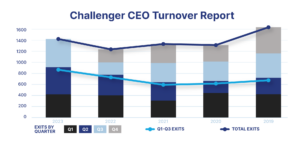CEO Turnover 2024: Navigating Retention and Succession Planning

CEO turnover in US companies soared to a record high in 2023. In the first three quarters alone, 1425 CEOs departed from their roles, marking a 47% increase from the previous year. This figure represents the highest number of resignations during the initial nine months of the year since 2002.
Among these departures, 22% were retirements, potentially postponed retirements from the preceding two years. Companies had retained their aging leadership during the tumultuous COVID-19 period, bidding farewell as circumstances stabilized. Not all exits were delayed retirements; 31% provided no reason, while the remainder pursued new opportunities, transitioned to other positions, resigned, or concluded interim roles.
As the CEO turnover rate escalates average CEO tenure drops, how can firms proactively address C-suite retention and navigate succession when inevitable exits occur? Deriving insights from Novo Exec’s executive team with over 20 years of experience assisting companies in executive recruitment, this article provides insight into these pressing questions.

In Picture: CEO turnover data in the first 3 quarters of the year. Source: ChallengerGray
The Cost of CEO Turnover
CEO Turnover is costly for companies. Expenses such as retaining an executive search firm, convening emergency leadership meetings, and covering costs for communication consultants, employment lawyers, movers, and relocation experts accumulate swiftly. And these are just the tangible, measurable impacts. They pale in comparison to the less visible costs, including turmoil, uncertainty, delays in project approvals, loss of potential deals, and employee attrition.
Both forced and planned successions impose costs on companies, but abrupt, unplanned changes carry a significantly higher price tag. According to PwC research, large companies experiencing forced successions in recent years could have generated an additional US$112 billion in market value in the year before and after turnover if they had executed planned successions. Even in cases where successions are planned, financial performance suffers in the year surrounding the change. In essence, changing leadership at the top always incurs a cost, but companies pay a much higher price when they force out their CEO.
What Triggers CEO turnover?
CEOs’ tenures are more sensitive than other C-suite executives due to their unique responsibilities and challenges. First, their strategic decisions are evident and subject to public and internal scrutiny. They’re also held responsible for the company’s performance by the board and stakeholders. Lastly, they’re the public face of the company and the first to be replaced when performance falters.
The primary factors leading to CEO turnover include:
- Financial Performance: There’s a strong link between CEO turnover and relative performance evaluation. A recent study reveals that 45% of CEO successions at companies in the bottom quartile are forced, compared to 21% for top-quartile companies. ‘Financial performance’ is a delicate balance between quantitative performance metrics and the qualitative market perception. A study of French firms revealed that accounting performance measures have greater weight than stock market performance in the board’s decisions, signifying their focus on long-term performance indicators.
- Power Dynamics Between The CEO & The Board: CEO turnover is often influenced by the delicate power dynamics in the organization. The same study of French firms highlights the considerable influence of the company’s main shareholder, holding at least 20% of voting rights, in CEO change decisions.
- Stakeholder Sentiment and Relationship Management: A CEO’s retention directly hinges on stakeholder sentiment. To maintain stakeholder confidence, they must maintain investors’ trust, customer confidence, and industry partnerships.
- Employee Approval: Employees are the backbone of any organization, and their approval impacts CEO retention. A study using 338 firms and 1,252 firm-year observations over eight years found that employee approval of CEO leadership, measured by data from Glassdoor.com, predicted CEO dismissal. The link was particularly evident in contexts of relatively good firm financial performance and when the CEO had less influence with the board.
- Other factors affecting CEO turnover: Other factors affecting CEO turnover include whether the firm is family-run, with results showing a negative direct effect on the probability of changing the CEO when a family controls the firm. A CEO from the family can extend their mandate despite a decline in the company’s performance. Factors such as CEO duality, CEO age, and outside directors also have a negative and significant relationship with CEO turnover.
How to Boost CEO Retention
CEO turnover is a mulifaceted phenomenon influenced by various factors, at times perceived as an inevitable or natural part of the leadership life cycle. Recent research indicates the median tenure of CEOs between 2018 and 2022 in Fortune 1000 companies was 3.5 years. While a long average tenure of the CEO has been linked with improved firm performance, a certain level of staff turnover at the top is deemed necessary. This integral part of the cycle allows senior executives to refine their professional acumen.
Companies aiming to bolster CEO retention can achieve this through tailored executive retention strategies. In instances of mergers/acquisitions, it is common to strategically offer CEO retention agreements and retention grants. However, the optimal solution also involves proactively preparing for transitions and minimising turnover costs, rather than solely focusing on employee retention. Here’s how to strategically plan for proper succession and mitigate the financial impact of turnover when it inevitably occurs.
Planning for CEO Succession
CEO succession planning shouldn’t commence after the CEO leaves; it’s a continuous process requiring strategic foresight, careful consideration, and proactive measures. It shouldn’t be treated as a one-time event but rather as an ongoing practice. Here’s how the CEO succession planning process should be approached:
1. Ownership and Accountability
CEO succession planning should be owned and led by the board, not solely delegated to the incumbent CEO. The board bears the responsibility for choosing the next leader, ensuring impartial decision-making. Recurring, candid discussions about succession should be integrated into board agendas.
2. Proactive Talent Development
Companies should proactively develop internal talent for CEO roles through lateral moves and international experience to prepare future leaders. Succession planning should extend beyond short-term decisions, focusing on a pipeline of potential leaders. CEOs and senior leadership teams should collaborate with the board to ensure ongoing leadership development at all levels.
3. Forward-Looking Approach
Succession planning should be forward-looking, considering the future needs of the company rather than relying solely on potential candidates’ past track records. Boards must assess what competencies will be vital for future success, especially in industries undergoing significant transformations. This approach ensures alignment with evolving business models.
Summing It Up
Implementing these practices helps boards navigate CEO retention and succession smoothly, mitigating the risks and costs associated with sudden leadership changes. By fostering a culture of proactive planning and talent development, organizations can ensure a seamless transition and maintain stability in the face of evolving business challenges. After all, effective CEO succession planning is a reflection of how well a company manages its enterprise as a whole.
References:
https://www.challengergray.com/blog/ceo-exits-continue-record-clip-164-ceos-leave-their-posts-in-september-2023-q3-highest-quarterly-total-on-record/
https://altrata.com/reports/c-suite-turnover-2023
https://www.strategy-business.com/article/00327#succession
https://www.cairn.info/revue-recherches-en-sciences-de-gestion-2018-6-page-29.htm
https://onlinelibrary.wiley.com/doi/10.1002/smj.3465?af=R
https://www.cairn.info/revue-recherches-en-sciences-de-gestion-2018-6-page-29.htm











